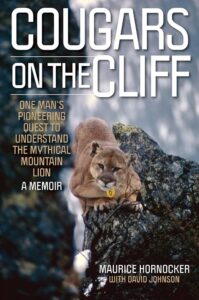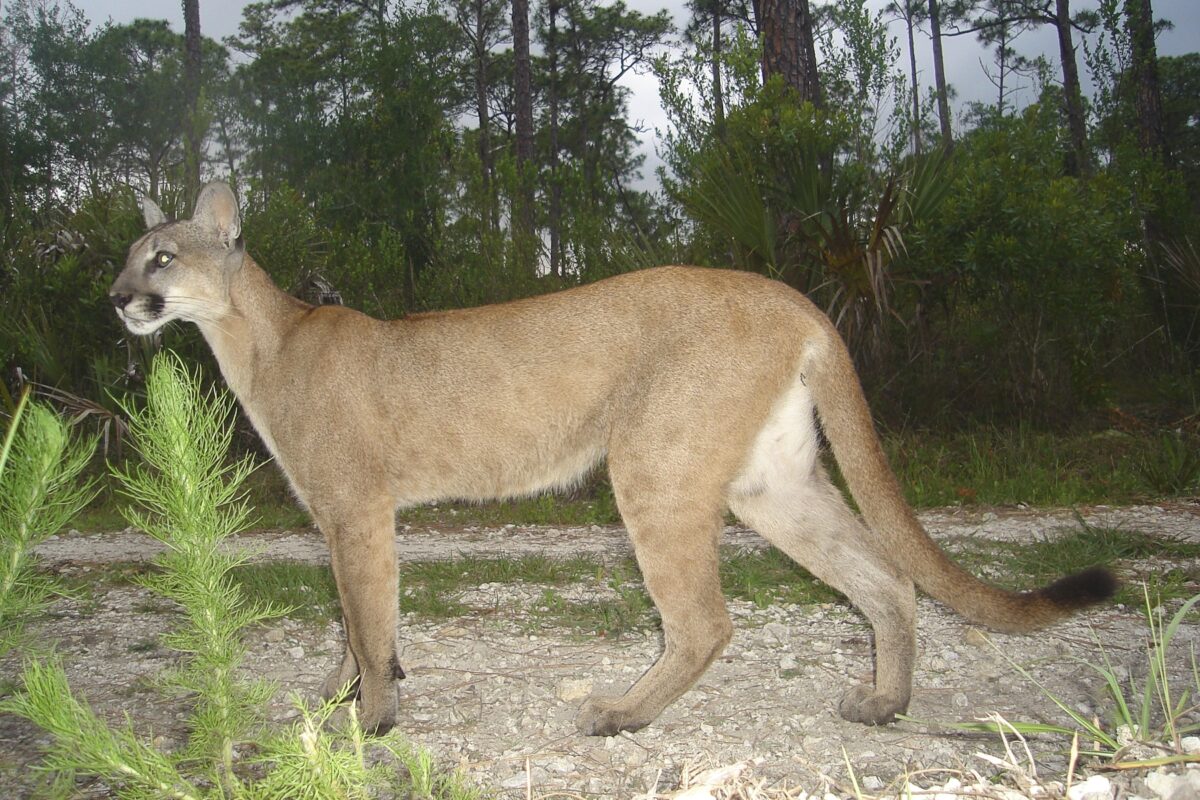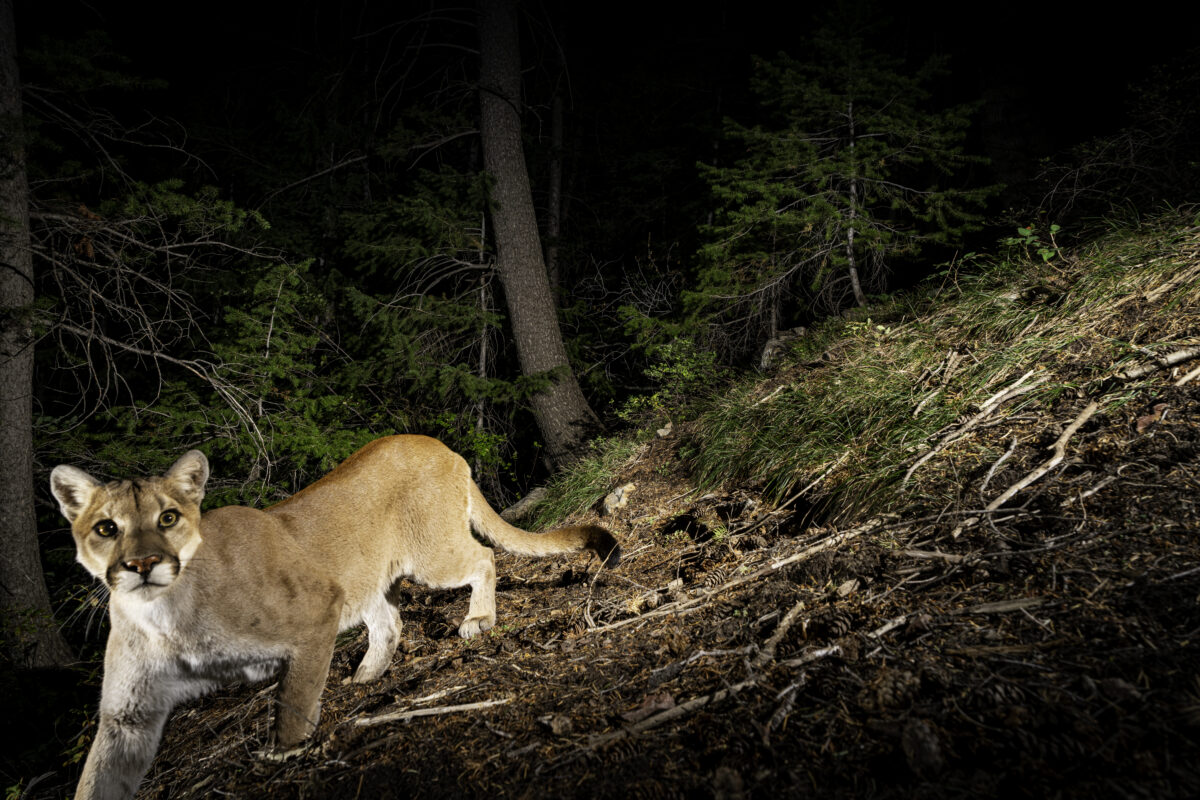
Dr. Maurice Hornocker is a world-renowned expert on big cats, especially mountain lions. His memoir “Cougars on the Cliff: One Man’s Pioneering Quest to Understand the Mythical Mountain Lion,” was recently released by Lyons Press and chronicles his ground-breaking study of cougar ecology sixty years ago in the Idaho Primitive Area. He agreed to answer the following questions posed by The Mountain Lion Foundation.
*The views represented here are those of the author, and they do not necessarily reflect those of the Mountain Lion Foundation.
————————————-
What’s the biggest change you’ve seen over your career in how researchers think about mountain lions?
The biggest change has been acknowledging the need for a better understanding of not just total numbers, but regional population differences and characteristics. Think of cats as coins in your pocket. Total value is important. But denomination of the coins is more revealing.
With deer, elk and fish, we’ve concentrated on total numbers because of the desirability of these species for either food or recreation. At the same time, we ignored the life history of species that kill other animals for food.
The sociology of individual regional populations is still lacking in cougar research. Mountain lions, because they are so adaptable, behave differently in the desert than they do in the rain forest, in the wilderness versus the outskirts of Los Angeles. So we must continue paying more attention to the denomination of the coins – the life history of these specific regional populations.
What’s the most surprising thing you’ve learned (about anything) by researching mountain lions?
Cougars are stay-at-homes.
Only newly independent young cats, or those who are ejected from their territory for various reasons, wander in search of permanent homes. The general thinking, according to the old scientific literature, was that they wander all over the place. Not so. They have home ranges and territories. And they stick to the territories unless there’s a natural disaster like forest fires, floods, or something regional that changes the home range acceptability.
In addition to being home bodies, mountain lion sociology, adaptability and population makeup has been surprising. For example, Yellowstone National Park and the nearby Jackson Hole area have virtually the same ecosystems. But our research showed that cougars behave entirely different in the two places. We attribute this to Yellowstone cougars living in a more natural environment compared to Jackson Hole where there’s more human encroachment and activity.
If you could allocate a large National Science Foundation grant to advance mountain lion research, what would be the research you would most like to move forward?
Again, there’s a need for more attention to regional populations. Southern and Northern California, for example, offer contrasting habitats. Mountain lion populations in both regions should be studied for differences and similarities. Accordingly, management should be based on those data.
Research should also focus on human-cougar interactions. People are moving into cougar habitat and increasing the likelihood for bad encounters. Home sites and concurrent landscaping attract deer. Deer attract cougars. Because cougars experience few if any negative experiences in these locations, lions can become habituated and pose a threat to pets and humans. Studies on ways to create negative experiences for cougars (ranging from physical harassment to high-frequency acoustical sounds and other deterrents) would be beneficial.
DNA studies may also lead to more management options. We should sample the DNA of cougars in regional populations and find out if there are differences. Some of these cats might be more likely to interact with or avoid humans? If so, studies on relocation or removal would be beneficial.
While the cats are highly adaptive, they can be stressed and behave in different ways in different habitats. Mountain lions, for example, behave differently in parks and refuges compared to areas where they become stressed by human activities like hunting. (By the way, I have never opposed hunting mountain lions, as long as populations are flourishing and the hunting is done legally and in an ethical manner.)
So DNA analysis might be one way to better understand population differences.
What are the biggest unanswered questions you see in mountain lion management?
If we’re going to manage regional populations, we need to know numbers, behavior and social structure. The recent state-wide census in California, estimating the cougar population at around 4,500, looks like a very thorough one. But we need to identify those specific areas in the state where distinct populations occur. The results could help guide further management options.
We must also gear management to minimizing cougar attacks on humans. Until recently, most of the attacks have occurred on Vancouver Island where there’s a stressed mountain lion population. The majority of human-cougar encounters involve young inexperienced cats. These cougars probably have had a tough time making a living and become habituated to areas occupied by humans where nothing negative happens to them. They hang around and became very bold, and sometimes very dangerous.
I’ve always recommended the prompt removal of such emboldened animals because if there’s one attack, then every cougar will be considered a criminal. It’s like the red-headed bank robber casting suspicion on all red-headed people.
Remember, mountain lions by nature shy away from humans. While conducting our ten-year study in Idaho’s wilderness, Wilbur Wiles and I never carried a gun. Many cougars had numerous opportunities to attack, but they never did. They tried to avoid us.
So problem cats should be removed or euthanized promptly with full public disclosure. [Animal shelters across the U.S.] euthanize hundreds of thousands of pets annually with no apologies. Eliminating emboldened mountain lions from our neighborhoods is better for both cougar conservation and human safety.
What would you say to wildlife agencies, community members, and media in states like Nebraska where mountain lions are beginning to return?
It’s all positive. Mountain lions are moving eastward across the country. Some places in states like Nebraska are over-populated with deer. The arrival of a major predator in such areas will be a positive influence for the entire ecosystem, just as wolves have become in Yellowstone National Park. People should be prepared and management agencies need to let the public know when the cats arrive.
That said, cougars are not going to grow out of control and kill all the deer. Nor will they adversely affect the hunting of deer by humans. Managers should emphasize the self-regulating nature of cougar populations which has been demonstrated in credible studies conducted throughout the mountain lion’s historic range.
Lastly, a lesson from Siberia where colleagues and I studied tigers for years. The indigenous people of Siberia consider healthy tiger populations an indicator of healthy forests. For that reason, the big cats are revered. The same could happen in the United States. Flourishing mountain lion populations might not only signal renewed understanding, but also vibrant ecosystems and in the long run a healthier wild America.



 Facebook
Facebook Twitter
Twitter Send Email
Send Email


